Of all the alternative liquids to make cold process soap with, beer may be one of the most popular. The natural sugars in beer add lather to the final bar, and are great from a marketing standpoint. If you’re a beer fan, who wouldn’t want to bathe with their favorite brew? For these Charcoal and Cedar Stout Bars, I teamed up with a local brewery, Wander Brewing. Wander is just a few blocks away from the Bramble Berry warehouse and is popular in the Bellingham community. I used their rich Correspondent Foreign Extra Stout for this project, and it served as the perfect base for these woodsy bars.
If you’ve never made cold process soap with beer before, it does require some extra prep. First, the alcohol and carbonation in beer needs to be boiled out for 10-15 minutes. Then, the beer needs to thoroughly cool before the lye can be added. Some soapers prefer to freeze the boiled beer and add the lye directly to the frozen beer to keep temperatures cool. If you’d like to read more about using alcoholic beverages in your cold process soap, check out this blog post.

For this project, activated charcoal and titanium dioxide are used to create a rich contrasting swirl. Due to the amount of charcoal, the lather of these bars is slightly gray, but I think they are worth it. You can always lessen the amount of charcoal to do away with the gray lather. =) The blend of cedarwood essential oil and fir needle essential oil is incredibly earthy and masculine. To help combat the acceleration that alcoholic beverages can cause in cold process soap, this recipe is palm oil free. To give the bars hardness, I added cocoa butter and coffee butter. Despite the butters, this is a soft recipe and will require extra time in the mold. I highly recommend using sodium lactate in this recipe to help the bars firm up in a timely manner.

If you can’t get your hands on some of Wander’s wonderful beer, any stout beer will work well. You can also use a lighter beer such as a pale ale. If you use a lighter beer for this project, the tan/creamy shade in the soap may be a bit lighter. Or, if you want to skip the beer all together you certainly can; simply use distilled water and soap as normal.
What You’ll Need:
18 Bar Birchwood Mold
Silicone Liner for 18 Bar Mold
5.8 oz. Cocoa Butter Pastilles (8.9%)
15.9 oz. Coconut Oil (24.5%)
2.9 oz. Coffee Butter (4.5%)
40.4 oz. Olive Oil (62.2%)
9 oz. Sodium Hydroxide Lye
21.5 oz. Prepared Beer
2 oz. Cedarwood Essential Oil
2 oz. Fir Needle Essential Oil
Activated Charcoal
Titanium Dioxide

Click here to add everything you need for this project to your Bramble Berry shopping cart!
If you’ve never made Cold Process soap before, stop here! I highly recommend checking out our FREE four part SoapQueen.tv series on Cold Process Soapmaking, especially the episode on lye safety. And if you’d rather do some reading, Bramble Berry carries a wide range of books on the topic, including my newest book, Soap Crafting. You can also checkout the digital downloads for that instant gratification factor.
SAFETY FIRST: Suit up for safe handling practices! That means goggles, gloves and long sleeves. Make sure kids, pets, and other distractions and tripping hazards are out of the house or don’t have access to your soaping space. Always soap in a well-ventilated area.
BEER PREP: To make soap with alcoholic liquid such as beer, the liquid first needs to be boiled in order to remove the alcohol and carbonation. Unboiled beer can react badly with lye and cause a bubbly volcano effect! For this tutorial, our neighbors at Wander Brewing generously donated some of their delicious Correspondent Stout. The wonderful dark color worked great for this recipe. If you prefer a different type of beer, I would recommend looking for another stout. Lighter beer works as well, but it will affect the colors of the final soap.
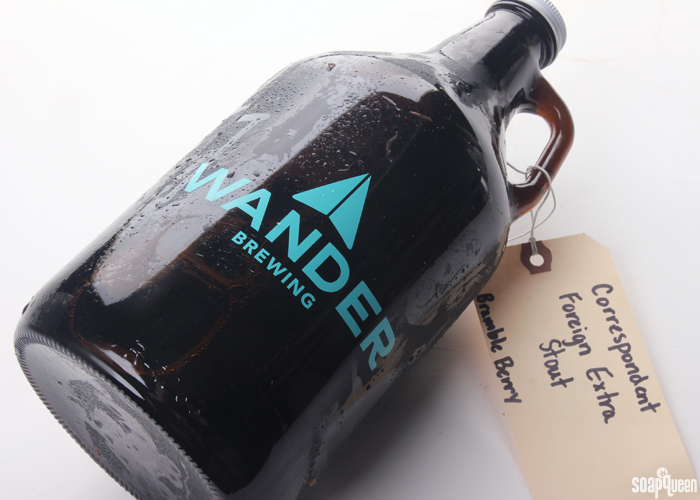 First, measure out the beer by weight. I recommend weighing out about 7-8 extra ounces to make up for the amount that will be lost as the beer is boiled. For example, in this recipe, I weighed out 28 ounces of beer. I only need 21.5 ounces of liquid. Once you have weighed the beer, transfer it to a stove top and bring to a boil. Reduce the heat and allow the beer to boil for 15 minutes. Do not leave the boiling beer unattended as it may boil over. Stir occasionally.
First, measure out the beer by weight. I recommend weighing out about 7-8 extra ounces to make up for the amount that will be lost as the beer is boiled. For example, in this recipe, I weighed out 28 ounces of beer. I only need 21.5 ounces of liquid. Once you have weighed the beer, transfer it to a stove top and bring to a boil. Reduce the heat and allow the beer to boil for 15 minutes. Do not leave the boiling beer unattended as it may boil over. Stir occasionally.
 Once the beer is done boiling, weigh the beer to see how much weight was lost. In this case, I was left with 20.7 ounces. The recipe calls for 21.5 ounces of liquid. The volume and weight measurements matched up so I decided to consider the amount missing as a small water discount. If you prefer to work with the full amount of liquid, add distilled water to your boiled beer to get the correct amount. Once the beer has been boiled, refrigerate it uncovered, overnight, to be sure that it loses as much alcohol and carbonation as possible. You may also choose to freeze the liquid and add the lye to the frozen beer.
Once the beer is done boiling, weigh the beer to see how much weight was lost. In this case, I was left with 20.7 ounces. The recipe calls for 21.5 ounces of liquid. The volume and weight measurements matched up so I decided to consider the amount missing as a small water discount. If you prefer to work with the full amount of liquid, add distilled water to your boiled beer to get the correct amount. Once the beer has been boiled, refrigerate it uncovered, overnight, to be sure that it loses as much alcohol and carbonation as possible. You may also choose to freeze the liquid and add the lye to the frozen beer.
 COLOR PREP: To ensure that the Titanium Dioxide blends smoothly into the soap batter, we recommend micronizing it before dispersing it in oil. Please note this is an optional tip but it does help with the titanium dioxide clumping in the soap. =) To micronize colorant, simply use a coffee grinder to blend the colorant to break up any clumps of color and prevent streaks of white from showing in the final soap. We like to use a coffee grinder that has a removable, stainless steel mixing area for easy cleaning. Then, disperse 1.5 tablespoons of the colorant into 1.5 tablespoons of sunflower or sweet almond oil (or any other liquid oil). Then in a separate container, disperse 2 tablespoons of activated charcoal into 4 tablespoons lightweight liquid oil. Use a mini mixer to help get rid of any clumps. Both of these dispersions are a little bit more concentrated than usual.
COLOR PREP: To ensure that the Titanium Dioxide blends smoothly into the soap batter, we recommend micronizing it before dispersing it in oil. Please note this is an optional tip but it does help with the titanium dioxide clumping in the soap. =) To micronize colorant, simply use a coffee grinder to blend the colorant to break up any clumps of color and prevent streaks of white from showing in the final soap. We like to use a coffee grinder that has a removable, stainless steel mixing area for easy cleaning. Then, disperse 1.5 tablespoons of the colorant into 1.5 tablespoons of sunflower or sweet almond oil (or any other liquid oil). Then in a separate container, disperse 2 tablespoons of activated charcoal into 4 tablespoons lightweight liquid oil. Use a mini mixer to help get rid of any clumps. Both of these dispersions are a little bit more concentrated than usual.
FRAGRANCE PREP: Measure 2 ounces of the cedarwood essential oil and 2 ounce of the fir needle essential oil in a glass, essential oil safe container. Set aside.
ONE: Remove the prepared beer from the fridge and begin to slowly add the lye to the beer. Gently stir until the lye has fully dissolved and the liquid is clear. My beer was quite cold (around 40 degrees) when I added the lye to it. As you can see below, it still got quite hot! Set aside to cool. The beer will smell unpleasant after adding the lye, but this scent will not be present in the final soap. The lye will also cause the beer to become darker. Because the stout is already quite dark, I did not try to prevent this from happening.
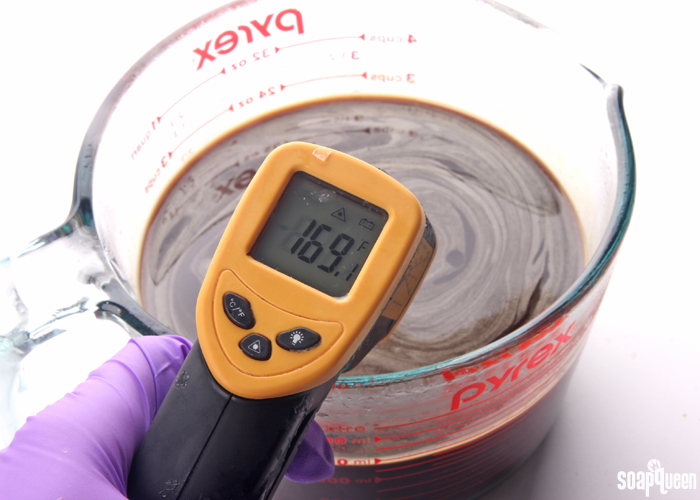 TWO: Melt and combine the coconut oil, cocoa butter, coffee butter and olive oil. Once the lye water and the oils have cooled to 130 degrees or below (and are ideally within 10 degrees of each other), add the lye water to the oils and stick blend until a very thin trace. If you’d like a harder bar of soap that releases faster from the mold, you can add sodium lactate to the cooled lye water. Use 1 teaspoon of sodium lactate per pound of oils in the recipe. For this recipe, you’d add about 4 teaspoons sodium lactate.
TWO: Melt and combine the coconut oil, cocoa butter, coffee butter and olive oil. Once the lye water and the oils have cooled to 130 degrees or below (and are ideally within 10 degrees of each other), add the lye water to the oils and stick blend until a very thin trace. If you’d like a harder bar of soap that releases faster from the mold, you can add sodium lactate to the cooled lye water. Use 1 teaspoon of sodium lactate per pound of oils in the recipe. For this recipe, you’d add about 4 teaspoons sodium lactate.

 THREE: Pour about 600 mL of the soap batter into a separate container. To this small container, add 1 tablespoon dispersed titanium dioxide and use a whisk to blend in the colorant.
THREE: Pour about 600 mL of the soap batter into a separate container. To this small container, add 1 tablespoon dispersed titanium dioxide and use a whisk to blend in the colorant.
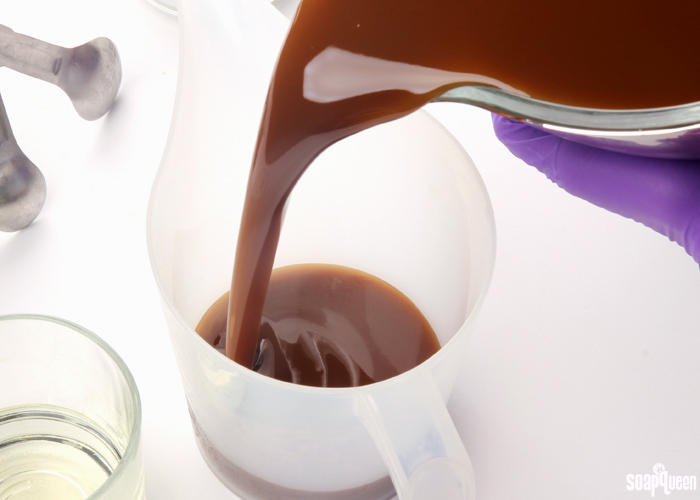 FOUR: To the large container of soap, add 2 tablespoons of dispersed activated charcoal and use a whisk to fully mix in.
FOUR: To the large container of soap, add 2 tablespoons of dispersed activated charcoal and use a whisk to fully mix in.
 FIVE: Add the essential oil blend to the soap containers proportionately, it’s okay to eyeball it! Use a whisk to fully blend in the essential oils.
FIVE: Add the essential oil blend to the soap containers proportionately, it’s okay to eyeball it! Use a whisk to fully blend in the essential oils.
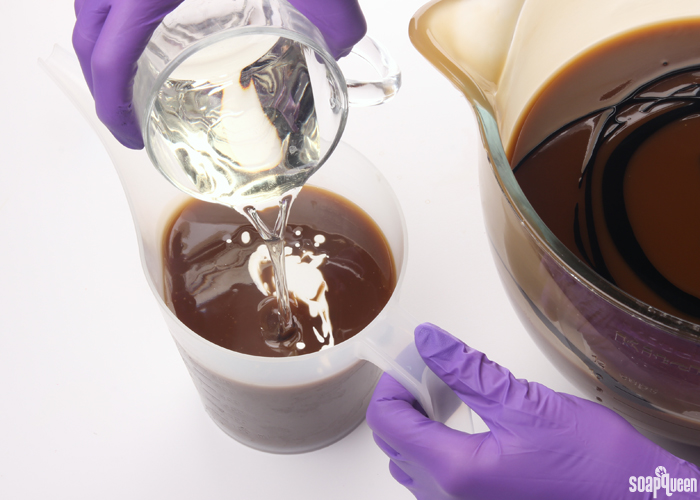 SIX: Pour all of the black soap into the mold, and tap the mold firmly on the counter to help eliminate bubbles.
SIX: Pour all of the black soap into the mold, and tap the mold firmly on the counter to help eliminate bubbles.
 SEVEN: Begin to pour the cream-colored soap across the length of the mold, going back and forth. For the first few pours, don’t worry if the soap breaks through into the black. After the first few initial passes, pour more gently into the soap to ensure the cream soap is staying on top of the black. Continue to pour in the same lengthwise direction until all the cream soap has been poured.
SEVEN: Begin to pour the cream-colored soap across the length of the mold, going back and forth. For the first few pours, don’t worry if the soap breaks through into the black. After the first few initial passes, pour more gently into the soap to ensure the cream soap is staying on top of the black. Continue to pour in the same lengthwise direction until all the cream soap has been poured.
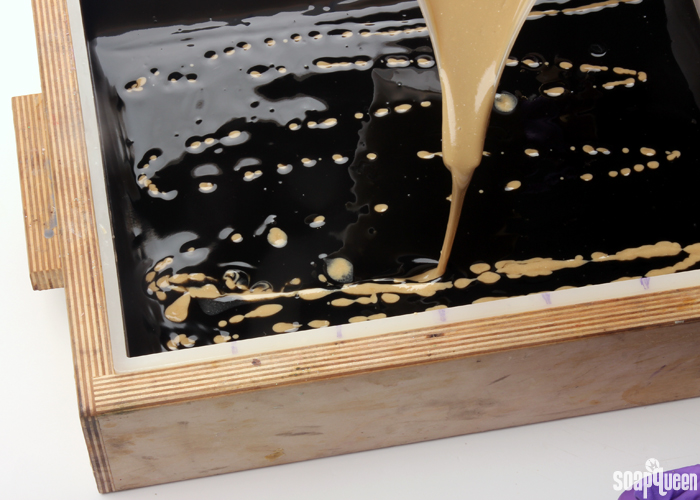
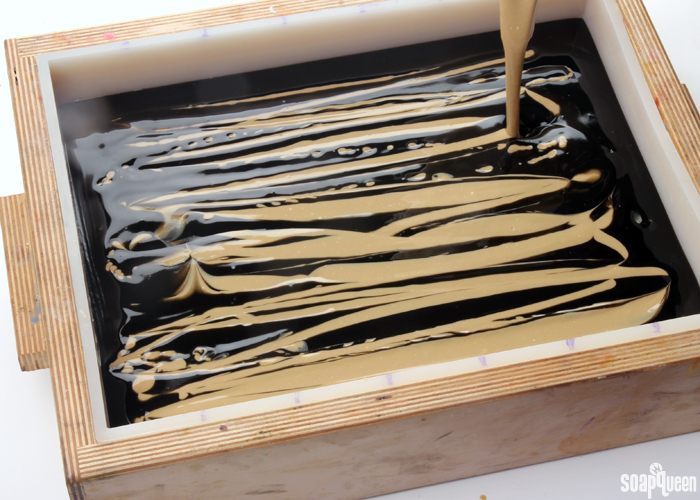 EIGHT: Insert a dowel or chopstick into the very top of the soap (about 1/4 inch into the soap), and drag it back and forth in the opposite direction of the cream soap lines using a S-shaped curve.
EIGHT: Insert a dowel or chopstick into the very top of the soap (about 1/4 inch into the soap), and drag it back and forth in the opposite direction of the cream soap lines using a S-shaped curve.
 Continue this pattern down the mold, until you reach the other end.
Continue this pattern down the mold, until you reach the other end.
 NINE: Clean off the dowel or chopstick, then insert it into the very top of the soap and drag the tool in an S-shaped curve down the length of the mold. Continue this pattern until you reach the other side of the mold.
NINE: Clean off the dowel or chopstick, then insert it into the very top of the soap and drag the tool in an S-shaped curve down the length of the mold. Continue this pattern until you reach the other side of the mold.
 TEN: Insert the dividers into the soap. Spritz the top of the soap with 99% isopropyl alcohol to help prevent soda ash. Allow this soap to harden in the mold for about 5-7 days before unmolding. Because this recipe is palm oil free and contains a lot of liquid oil, it requires more time to harden in the mold. Once ready to unmold, gently remove from the dividers and allow to cure for 4-6 weeks. Enjoy!
TEN: Insert the dividers into the soap. Spritz the top of the soap with 99% isopropyl alcohol to help prevent soda ash. Allow this soap to harden in the mold for about 5-7 days before unmolding. Because this recipe is palm oil free and contains a lot of liquid oil, it requires more time to harden in the mold. Once ready to unmold, gently remove from the dividers and allow to cure for 4-6 weeks. Enjoy!

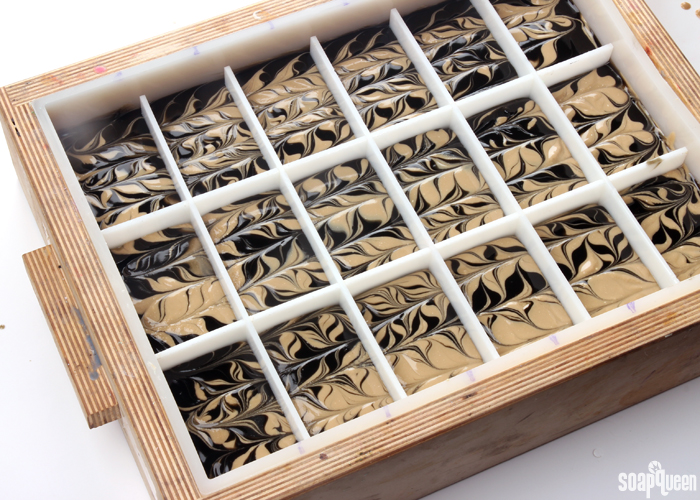 To give these bars a more polished look, I used the Soap Shaver to create a smooth top and the Soap Beveller to create smooth edges. I waited about one week after unmolding to use these tools, because the soap was still on the soft side.
To give these bars a more polished look, I used the Soap Shaver to create a smooth top and the Soap Beveller to create smooth edges. I waited about one week after unmolding to use these tools, because the soap was still on the soft side.

Have you ever used beer, or another alcoholic liquid in your soap before? While it does require an extra step, beer, wine and champagne soap are such crowd pleasers!
- 18 Bar Birchwood Mold
- Silicone Liner for 18 Bar Mold
- 5.8 oz. Cocoa Butter Pastilles (8.9%)
- 15.9 oz. Coconut Oil (24.5%)
- 2.9 oz. Coffee Butter (4.5%)
- 40.4 oz. Olive Oil (62.2%)
- 9 oz. Sodium Hydroxide Lye
- 21.5 oz. Prepared Beer
- 2 oz. Cedarwood Essential Oil
- 2 oz. Fir Needle Essential Oil
- Activated Charcoal
- Titanium Dioxide
First, measure out the beer by weight. I recommend weighing out about 7-8 extra ounces to make up for the weight that will be lost as the beer is boiled. For example, in this recipe, I weighed out 28 ounces of beer. I only need 21.5 ounces of liquid. Once you have weighed the beer, transfer it to a stove top and bring to a boil. Reduce the heat and allow the beer to boil for 15 minutes. Do not leave the boiling beer unattended as it may boil over. Stir occasionally.
Once the beer is done boiling, weigh the beer to see how much weight was lost. In this case, I was left with 20.7 ounces. The recipe calls for 21.5 ounces of liquid. I decided to consider the amount missing as a small water discount. If you prefer to work with the full amount of liquid, add distilled water to your boiled beer to get the correct amount. Once the beer has been boiled, refrigerate it uncovered, overnight, to be sure that it loses as much alcohol and carbonation as possible.
- Remove the prepared beer from the fridge and begin to slowly add the lye to the beer. Gently stir until the lye has fully dissolved and the liquid is clear. My beer was quite cold (around 40 degrees) when I added the lye to it. As you can see below, it still got quite hot! Set aside to cool. The beer will smell unpleasant after adding the lye, but this scent will not be present in the final soap. The lye will also cause the beer to become darker. Because the stout is already quite dark, I did not try to prevent this from happening.
- Melt and combine the coconut oil, cocoa butter, coffee butter and olive oil. Once the lye water and the oils have cooled to 130 degrees or below (and are ideally within 10 degrees of each other), add the lye water to the oils and stick blend until a very thin trace. If you’d like a harder bar of soap that releases faster from the mold, you can add sodium lactate to the cooled lye water. Use 1 teaspoon of sodium lactate per pound of oils in the recipe. For this recipe, you’d add about 4 teaspoons sodium lactate.
- Pour about 600 mL of the soap batter into a separate container. To this small container, add 1 tablespoon dispersed titanium dioxide and use a whisk to blend in the colorant.
- To the large container of soap, add 2 tablespoons of dispersed activated charcoal and use a whisk to fully mix in.
- Add the essential oil blend to the soap containers proportionately, it’s okay to eyeball it! Use a whisk to fully blend in the essential oils.
- Pour all of the black soap into the mold, and tap the mold firmly on the counter to help eliminate bubbles.
- Begin to pour the cream-colored soap across the length of the mold, going back and forth. For the first few pours, don’t worry if the soap breaks through into the black. After the first few initial passes, pour more gently into the soap to ensure the cream soap is staying on top of the black. Continue to pour in the same lengthwise direction until all the cream soap has been poured.
- Insert a dowel or chopstick into the very top of the soap, and drag it back and forth in the opposite direction of the cream soap lines using a S-shaped curve. Continue this pattern down the mold, until you reach the other end.
- Clean off the dowel or chopstick, then insert it into the very top of the soap (about ¼ inch into the soap), and drag the tool in an S-shaped curve down the length of the mold. Continue this pattern until you reach the other side of the mold.
- Insert the dividers into the soap. Spritz the top of the soap with 99% isopropyl alcohol to help prevent soda ash. Allow this soap to harden in the mold for about 5 days before unmolding. Because this recipe is palm oil free and contains a lot of liquid oil, it may require more time to harden in the mold. Once ready to unmold, gently remove from the dividers and allow to cure for 4-6 weeks. Enjoy!
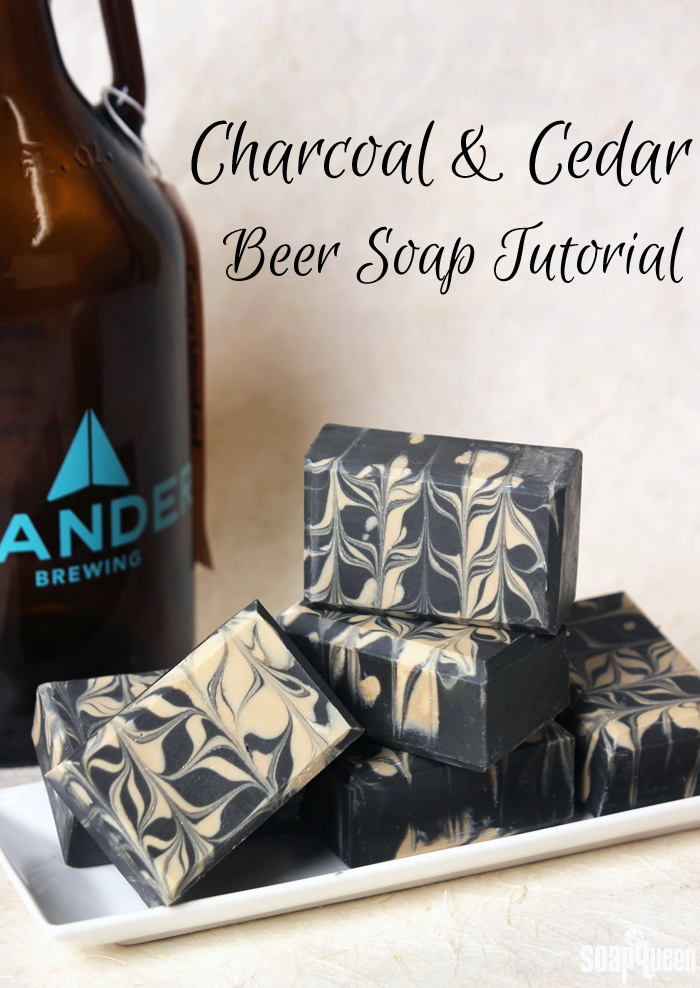
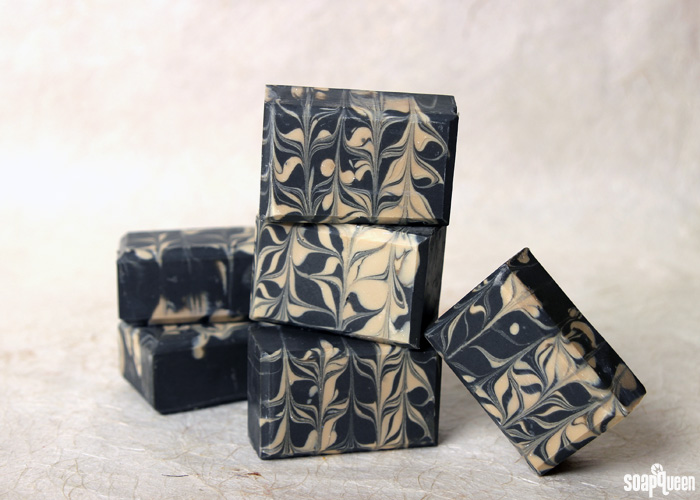




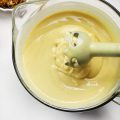
Can I substitute my 10″ silicon mold? I have several.. ..
Yes, you can use that mold for this recipe. Learn how to resize your recipe here: https://www.soapqueen.com/bath-and-body-tutorials/tips-and-tricks/how-to-resize-cold-process-soap-recipes/
10″ Silicone Loaf Mold: https://www.brambleberry.com/10-silicone-loaf-mold–p5199.aspx
I used this recipe but with no colorant, no beer and a different fragrance oil. It’s still really soft, it’s been over a week! I’m just letting it cure for longer I guess. I hope it hardens up! I will try this recipe again though as I love the mix of oils with the butters!
Was the soap pretty thin when it was poured? Also, how are you storing that soap? How thick the soap is and the temperature can affect how long it takes to unmold.
I just received all of the ingredients to make this awesome looking soap. I will not be using beer in my recipe, so I will just use distilled water. Also, the coffee butter smells so good that I’ve decided to use that in a different recipe instead of this one.
My question is, what can I used in place of the coffee butter? I would prefer something that will not add to the scents that I will be using. I plan to use two parts FO and 2 parts EO in this recipe. Should any other changes be made to accommodate the substitutions in this recipe? Thanks!
In place of the coffee butter, you can use avocado butter. It has a similar soft consistency, but a more subtle scent than the coffee butter: https://www.soapqueen.com/bath-and-body-tutorials/charcoal-cedar-beer-cold-process-soap-tutorial/
You can use shea butter too, but because it’s firmer than the coffee butter the consistency of your soap will be firmer. You may want to make a small test batch to see what you think.
Remember to run your recipe through the Lye Calculator after any substitutions: https://www.brambleberry.com/Pages/Lye-Calculator.aspx
Learn more about butters here: https://www.soapqueen.com/bath-and-body-tutorials/tips-and-tricks/all-about-butters-in-bath-beauty-products/
Another thing to consider is the color. It will be lighter without the beer, so you may need more charcoal and less titanium dioxide to get the color shown here.
-Kelsey with Bramble Berry
Shea butter: https://www.brambleberry.com/Shea-Butter-P3220.aspx
This soap was so much fun to make, the first day the house smelled like a brewery and the second day we had cedar permeating every nook. I just tried the first bar and the lather was really creamy. I will be making this one again. By the way, my batch did not turn out as pretty as yours, but still had an interesting marbled design.
That’s awesome Jill, glad the soap turned out well! We really enjoyed the beer/woodsy scent it created in the Soap Lab. 🙂
-Kelsey with Bramble Berry
Hello and thank you for this beautiful recipe which I am going to try, but I would like to know how to resize the colorants. I would like to use only 32 oz of oils.
Thank you very much!
You’ll want to prep half as much color! The 32 oz. is about half of the original oil weight. So, .75 Tbsp. of titanium dioxide into .75 Tbsp. of oil, and 1 Tbsp. of charcoal into 2 Tbsp. of oil. 🙂
-Kelsey with Bramble Berry
I want to follow this recipe but I don’t have an 18 bar mold. Can I line a cardboard box and use that? If so, what size box should I use? Also since I wouldn’t have the dividers, can I unmold and cut into bars by hand? So far I have been lining egg beater cartons and cutting when I unmold, working great, but to attempt this swirl pattern I think I need a flatter box mold. Thank you!
You can line a cardboard box and use that instead! To find out how much soap it holds, I would recommend lining the box with freezer paper and placing it on a scale. Then, zero the scale out and pour in water until the soap is where you want it. That will give you a rough estimate of how much soap the mold holds. Water and soap do have different densities so it won’t be an exact measurement, but it will be pretty close. Then you can make extra soap just in case. 🙂
Learn how to line that box here: https://www.soapqueen.com/bath-and-body-tutorials/cold-process-soap/how-to-line-any-mold/
Also, you can cut the bars by hand! We find a ruler really helps you get those straight lines. We did that for this soap made without dividers: https://www.youtube.com/watch?v=lypXN_7aB3A
-Kelsey with Bramble Berry
Hi, beautiful soap!!! I made a beautiful too, but some person told me that they are disapointed because the bubbles are black (grey) also The soap made the black résidu on the soap tray !?!?! For a batch of 600 grammes of oils I added 1 gramm of actived charcoal. Is it normal? Do you have the samething? Tank you so much.
Oh I’m sorry about that! If too much charcoal is used, the soap can lather gray/black. I would recommend using about .5-.75 grams of activated charcoal for your next batch. That should prevent any color transfer. 🙂
-Kelsey with Bramble Berry
Tank you so much!!!
You’re welcome! 🙂
Hello ,will you please help me to find solution for the acne problem of my daughter,plus the darkening of her nape and neck,what soap should I used for her..its been a problem since her adolescence period..thank u so much for the reply😊
Hi Ghie!
We don’t have any recipes that help fight acne. Those are considered a drug by the FDA and regulated that way. We make soap and cosmetic recipes instead. We do have some great facial bar recipes you may like though! They’re cleansing and gentle on the skin. I’ll link them below. 🙂
Cleansing Bars for Dry and Oily Skin: https://www.soapqueen.com/bath-and-body-tutorials/melt-and-pour-soap/cleansing-soap-dry-oily-skin/
Sea Clay Avocado Facial Bar: https://www.soapqueen.com/bath-and-body-tutorials/cold-process-soap/sea-clay-avocado-facial-bar/
Thyme and Witch Hazel Facial Bar: https://www.soapqueen.com/bath-and-body-tutorials/cold-process-soap/guest-post/
-Kelsey with Bramble Berry
I love all of your recipes! I’m starting to make local Michigan craft beer soaps, but was wondering if you knew anything about Trademark issues. Would I be “allowed” to market my soaps as, “Beer Soap using Short’s Brewery’s Strawberry Shortscakes,” for example? I would really appreciate any insight!
Thank you,
Allison
To be honest I’m not quite sure! I checked Marie Gale’s book, Soap and Cosmetic Labeling, and it says, “the trade or brand name of an ingredient is not acceptable to use in the ingredient declaration. Your supplier should be able to provide you with the correct common name for any ingredient.” However, I think that may apply more to using the common names of products to avoid confusion. For instance, you would want to say “coconut oil” versus just listing a brand name. I have also seen people using the name of the beer in soap – it’s usually a selling point!
To be 100% sure, I would recommend contacting the FDA. They can let you know how to list that beer. 🙂
Find their contact information here: http://www.fda.gov/AboutFDA/ContactFDA/default.htm
Marie Gale’s book also has lots of helpful information about labeling: https://www.brambleberry.com/Soap-And-Cosmetic-Labeling-Book-1-Book-P3663.aspx
-Kelsey with Bramble Berry
Hey Kelsey,
Another question! I’ve been making beer/wine soap these past few weeks and the recipes have been cracking and crumbly (yuck!). I’ve been cooking down the beer and then measuring by volume. For example, if I need about 8 ounces of liquid in my recipe, and only have about 6.5 weighted ounces in beer, so I sub the remaining 1.5 for water. Should I be using the cooked down beer by volume? I see all the rest of the recipes instruct that volume is the correct way, but here you are using weight. I’m assuming I’m doing a water discount by using the beer by weight, versus volume. Is that correct?
Also, the recipe I am using is the beer recipe in the Natural Soapmaking book (but doubled so it can fill my 5lb loaf mold).
What might you suggest?
Thank you,
Allison
We have tried measuring the beer/wine by volume and weight. Both work well, but we typically use weight! We find that a bit more accurate. Filling up the rest with water is what we recommend! I’m wondering if the cracking may be heat related. How hot are your temperatures, and where are you storing the soap? Also, how much butter is in your recipe? Thanks!
-Kelsey with Bramble Berry
How long does the soap keep? Is there a difference between the cold and hot process as far as long long they will stay good?
Hi Julie!
The shelf life of the soap depends on the oils added rather than the method used! Both cold and hot process soap have similar shelf lives. The oils in this recipe have a shelf life of a year or so, so the soap will be good for that long. If there was a shorter shelf life oil like hazelnut oil (3 months), the soap would be good for about 3 months. 🙂
Read more about shelf lives here: https://www.soapqueen.com/bath-and-body-tutorials/tips-and-tricks/shelf-life-bath-products-ingredients-rancidity-vs-mold/
This post has a list of oil shelf lives and is really helpful too: http://www.soapqueen.com/bath-and-body-tutorials/tips-and-tricks/free-beginners-guide-to-soapmaking-common-soapmaking-oils/
-Kelsey with Bramble Berry
Is there a sub for the beer? Also looking for more Activated charcoal recipes.
Thanks
Hi Debra!
Absolutely, there are several liquid options for cold process soap! You can use another beer, wine, tea, milk, etc. You can also use distilled water. I’ll link some posts below that talk about liquid options for soap. 🙂
How to Use Alcoholic Beverages in Cold Process Soap: https://www.soapqueen.com/bath-and-body-tutorials/lotion/how-to-create-homemade-lotion-recipes/
How to Add Lye to Milk for Cold Process Soap: http://www.soapqueen.com/bath-and-body-tutorials/tips-and-tricks/how-to-add-lye-to-milk-for-cold-process-soap/
Exfoliating Green Tea Bars: https://www.soapqueen.com/bath-and-body-tutorials/cold-process-soap/exfoliating-green-tea-cold-process-bars/
We also have a few cold process recipes made with activated charcoal you may like. It creates a lovely black hue. I’ll link a few below!
Gold Mine Cold Process Soap: https://www.soapqueen.com/bath-and-body-tutorials/gold-mine-cold-process-soap-tutorial/
Creamy Cow Milk Cold Process Tutorial: https://www.soapqueen.com/bath-and-body-tutorials/cold-process-soap/creamy-cow-milk-cold-process-tutorial/
-Kelsey with Bramble Berry
Is the beer measured in this recipe by weight or by volume?
Lots of thanks!
The beer in this recipe is measured by weight! We recommend weighing out 7-8 ounces extra because some of the liquid will boil off. We measured out 28 ounces of beer and ended up with about 21.5 ounces. 🙂
Read more about weight vs. volume here: http://www.soapqueen.com/bath-and-body-tutorials/tips-and-tricks/a-guide-to-weight-vs-volume/
-Kelsey with Bramble Berry
Thank you so much, Kelsey 🙂 I shall do so.
You’re welcome! 🙂
Hello, I made this recipe using the ingredients as listed, and the correct amounts. I used a porter instead of the stout. So, why did my blacks turn a hideous green?? Will that change as it dries? I did use Ancient Sedona fragrance since I did not have the essential oils. Could that have caused the color change with the activated charcoal?? It’s too soft to cut now, so I have to wait a few more days before I can see if my drop swirl pattern worked. I sure hope the color changes as it dries tho. It doesn’t look like the pictures on your website!
Hi Melanie!
Oh no, I’m sorry about that! Ancient Sedona Fragrance Oil does discolor tan, but shouldn’t cause a green color. I’m wondering if it was the beer. There may be an ingredient in there that’s reacting with the soap to cause that color. I would recommend making a small test batch of this recipe with distilled water to see if that green color still shows up. If not, you can try a different beer, or use the green color in your design somehow!
The good news is the soap should be just fine to use on the skin. To be extra careful, I would recommend pH testing it after about 5 days: http://www.soapqueen.com/bath-and-body-tutorials/tips-and-tricks/test-ph-red-cabbage/
-Kelsey with Bramble Berry
Ancient Sedona Fragrance Oil: https://www.brambleberry.com/Ancient-Sedona-Fragrance-Oil-P3342.aspx
I was wondering what kind of lather I’d get with this soap. The guys in my family like lots of lather. I’ll be making a substitution too – using the avocado butter instead of coffee butter and resizing to use my 4″ silicone mold. Can you tell me what kind of soap I’ll get? Or would you suggest a different soap recipe? I do have the book and there’s an Ale recipe in it. Thank!
Hi Nitza!
The lather on this soap is nice! It has a creamy lather with medium-size bubbles. If you prefer bigger, fluffy bubbles, I would recommend adding castor oil. Castor oil at 2-5% gives the recipe nice big bubbles. You can reduce the amount of olive oil to add the castor oil. 🙂
Read more about castor oil here: https://www.soapqueen.com/bath-and-body-tutorials/tips-and-tricks/sunday-night-spotlight-castor-oil/
Also, coffee and avocado butter have a similar texture, so avocado is a good substitute. Just make sure to run your recipe through the Lye Calculator again after any substitutions: http://www.brambleberry.com/Pages/Lye-Calculator.aspx
This post on substituting oil in cold process recipes is helpful as well: http://www.soapqueen.com/bath-and-body-tutorials/tips-and-tricks/how-to-substitute-oil-in-cold-process-recipes/
-Kelsey with Bramble Berry
I’m a bit disappointed. The bars came out beautifully out of the mold. However, days later soda ash appeared all over the soap bars (top & sides). I had sprayed the tops with alcohol but I still got soda ash. When I saw the soda ash appear I quickly sprayed the sides too. But did’t help. Did I do something wrong?
Hi Nitza!
I’m sorry about that. Soda ash can definitely be a bit pesky. The good news is you can remove it! You can use steam or an old nylon to remove it. Learn how to do that in the Explaining and Preventing Soda Ash post: http://www.soapqueen.com/bath-and-body-tutorials/tips-and-tricks/explaining-and-preventing-soda-ash/
To help prevent it, we recommend spraying the top of the soap with alcohol as soon as it’s in the mold. That creates a barrier to prevent the soda ash from forming. You can spray with alcohol every 15 minutes for the first hour.
Even with alcohol, soda ash can sometimes appear. Soaping at higher temperatures (100-130F) and pouring the soap when it’s a bit thicker helps prevent it. You can also lower the superfat slightly, or water discount the soap. Learn how to water discount here: http://www.soapqueen.com/bath-and-body-tutorials/tips-and-tricks/water-discounting-cold-process-soap-how-why/
The soda ash post has more great tips for preventing it as well! 🙂
-Kelsey with Bramble Berry
Lovely recipe 🙂 Is there any substitute I can use for coffee butter?
Also, can I substitute the Active Charcoal with Black Pigment?
Hi Demos!
In place if the coffee butter, you can use avocado butter! Both avocado and coffee butter have a soft and luxurious texture. If you don’t have avocado butter on hand, you can increase the amount of cocoa butter. Keep in mind that will make the bars a bit more firm, as cocoa butter has a firmer texture than coffee butter. Make sure to run the recipe through the Lye Calculator after any substitutions: http://www.brambleberry.com/Pages/Lye-Calculator.aspx
This post on substituting oils in cold process soap may be helpful for you as well: http://www.soapqueen.com/bath-and-body-tutorials/tips-and-tricks/how-to-substitute-oil-in-cold-process-recipes/
Also, you can use black oxide in this recipe as well! I would recommend prepping the same amount of colorant, then adding it 1 dispersed teaspoon at a time until you get a color you like. 🙂
-Kelsey with Bramble Berry
Thanks for the tips. At the end of the day I managed to get hold of all the ingredients. This is my first soapmaking experience, I just finished and I can’t wait to see the results 😀 Thanks for the amazing tutorial!
You’re welcome! Have fun. 🙂
If selling these, how would I list the beer I my ingredients? Would I use the brand name, type, or list all of the ingredients in the beer?
Hi Audrea!
That’s a great question! To be honest I am not 100% sure. Most beer companies don’t list their ingredients, so it can be tricky to find them. And if they do, they likely won’t have the percentage of the ingredients used, which can be tricky when labeling. Because of that, I would think that listing just “beer” on the label would be fine. You could also list the brand in case customers want to look up the ingredients themselves.
To be 100% sure, I would recommend contacting the FDA. Their employees should be able to give you more information. 🙂
FDA Contact Form: http://www.fda.gov/AboutFDA/ContactFDA/default.htm
-Kelsey with Bramble Berry
Hi There, Fabulous recipe – I am going to give this a go! I have a quick question – sorry if someone has asked this before and you have to repeat – I’ve surfed previous comments but may have missed it. Can I replace the titanium dioxide with non nano zinc oxide. Only ask because I have a large bag of it! I mis-ordered the amount to make make sunscreen for my ridiculously sensitive skin but if I can use it in soap….
Thanks.
Also just a wee note – I just bought Pure Soapmaking and I LOVE it. 🙂
Have a great Sunday night. Nadeen x
So I made it – and it sooooo lovely. It looks gorgeous – although it’s my first Taiwan swirl and I definitely need a LOT more practise. But I am really happy with it.
As with all recipes, I use these ones at Brambleberry as inspirations for patterns etc rather than following to the letter. I always re-calibrate the measurements to fit my massive 40cm x 28cm mould and then convert to grams, then run it through a lye calculator. In that respect, measuring out 600mls bit wasn’t applicable, so after I reached light trace, I quickly mixed in the essential oils, then measured off 40% for white part and left 60% for the black. And I also do use Palm oil because I get mine from (reliable) sustainable source who buys from a small freedom farm in South America who desperately need the money. And I did add castor oil in place of the coffee butter, because I don’t use that oil in my soaping.
But essentially my base recipe was a high percentage olive oil soap, as this one suggests. 🙂 One thing I noted which may be to do with the different beer types, I mixed the lye into the cold boiled beer using a very cold water bath – but still had to do it super slowly because at one point it was 75deg celcius. Ekk. I had a few hours so time wasn’t a problem there. It did not trace quickly for me. Took a good 10-15minutes. I was happy with this because I could control the soap batter – meaning better pouring patterns. The last 2 soaps I did, traced to gloop in 60secs. Oi vo. Nightmare.
My two learning experiences – in case anyone is undertaking this recipe are 1) You need a proper pouring jug with a skinny spout to make good free-pour lines in the soap, which I didn’t but I managed to salvage it….and 2) Hide the beer! I bought a lovely artisanal beer but my husband drank it. I only realised this to be the case this morning when I was ready to start soaping!!!! This is possible grounds for sleeping on the sofa tonight. Don’t come between a girl and her soap. 😉
I would definitely add this soap to my list of regulars. I think it is particularly beautiful to look at – very manly but also very hotel-sophisticated.
Thanks to the team at Brambleberry for the never ending inspiration. 🙂 xx
Yay, so happy this soap turned out well Nadeen! Thanks so much for sharing your tips as well. I know they’ll be helpful for anyone trying this recipe (or anyone with a beer-loving spouse!) Also (as you probably know), you can use zinc oxide to help whiten this recipe. 🙂
Zinc oxide: https://www.brambleberry.com/Zinc-Oxide-P5046.aspx
-Kelsey with Bramble Berry
Hi, I can’t wait to try this recipe, but I have a few questions:
1. Is there a difference between Cocoa Butter Pastilles and blocks of cocoa butter?
2. Will the type of beer affect the smell?
3. Can other types of essentials oils work? I’m looking for something a bit less masculine than Cedar Wood and Fir Needle. Maybe Bergamot? If I use a different type of essential oil, should I run it through the lye calculator?
Thanks!
Hi Lenny!
Cocoa butter pastilles and blocks are the same! They are just in different forms. The pastilles are a bit easier to measure and melt and have a slightly milder chocolate scent than the chunks. Either form works well in this recipe. 🙂
Cocoa butter pastilles: https://www.brambleberry.com/Cocoa-Butter-Pastilles–P3218.aspx
Cocoa butter chunks: https://www.brambleberry.com/Cocoa-Butter-Chunks-P6365.aspx
The beer scent will be quite strong at first, but will mellow as it cures. The final bars will have a slight beer scent. It may be stronger depending on the type of beer you use. For instance, a stout may have more of a smell than a light ale. I like the scent it has, but you may want to make an unscented small test batch just in case. That way you can give it a smell and see what you think.
You can use any skin safe essential oil you like! Bergamot would smell really nice. It would add some freshness to this recipe. Balsam Peru is another option. It has tobacco notes reminiscent or vanilla that would mix well with the beer and cocoa butter. 🙂
The essential oil usage rates will vary based on what kind they are! To find out how much to essential oil add, you can use our Fragrance Calculator: https://www.brambleberry.com/Pages/Fragrance-Calculator.aspx
-Kelsey with Bramble Berry
Bergamot pure essential oil: https://www.brambleberry.com/Bergamot-Pure-Essential-Oil-P3414.aspx
Balsam Peru essential oil: https://www.brambleberry.com/Balsam-Peru-Essential-Oil-P4443.aspx
hi soapqueen..
wow such a lovely colour!!
at one time, ive made a lot of bamboo charcoal soap..
to very black to grey colour depend on the amount..
just wondering, did bamboo charcoal soap drying the skin?
or is it just my sensitive skin..?
im just using 1/2 tsp of it and using only food grade bamboo charcoal,and after using it my skin feels dry and firm..
i have many charcoal soap not in use,
not giving to anyone cos afraid of the effect.
have anyone experience this?
Hi Jasmine!
Everybody’s skin is a little bit different! I don’t find the charcoal drying on my skin, that may be different for someone else. That being said, there are several other factors that can affect the feeling of the soap. What ingredients did you use in your soap? Did you add any clay to the batch? Let me know and I can suggest some ingredients for a super moisturizing recipe. 🙂
-Kelsey with Bramble Berry
hi kelsey ,thanks for quick reply!
since total charcoal coloured soap is drying myskin ,i only did charcoal swirl to my soap..
and it was fine, i still can get the benefit.. 😉
You’re welcome Jasmine! 🙂
-Kelsey with Bramble Berry
I can’t afford these types of molds and only have wooden molds that I line with freezer paper. it saves for my final costs and I like it that way. Is there any way that I can find out what measurements I need for this amount of final product. I free hand cut my product as many like the homemade looking product. Myself I prefer all the work that goes into the final product like I make it. I waste nothing and never cut bars to shape. Thank you, I’ll try to find my way back to the blog so I cna see if anyone can help me with this.
Hi Deb!
I can definitely help you out! Do you know how much soap your mold holds? Let me know and I can give you some tips to get similar size bars. 🙂
-Kelsey with Bramble Berry
Hi, I lov your recipes!!!
What could i use instead of the coffeebutter? I have mango butter,? Or could i just use more cocoabutter, instead? Will it make a difference if i use plain cocoa butter instead if the pastilles? Should i just try it?
I love experimenting with different oils!!
Thanks
A
Hi Andrea!
Experimenting with oils is so fun! For this recipe, I would recommend substituting the coffee butter for avocado butter. They have similar textures and make great substitutes. 🙂
If you like, you can also increase the cocoa butter to cover the coffee butter. Cocoa butter is a bit more firm, so it will make the recipe more firm overall. Also, make sure to run your recipe through the Lye Calculator after any substitutions: https://www.brambleberry.com/Pages/Lye-Calculator.aspx
This post on substituting oils in cold process soap may be helpful for you as well: http://www.soapqueen.com/bath-and-body-tutorials/tips-and-tricks/how-to-substitute-oil-in-cold-process-recipes/
-Kelsey with Bramble Berry
I am wondering if you have given any thought of adding ingredient lists for labels to your recipes here. I use predominately recipes from this site and the labeling process is overwhelming me to say the least 🙂
I am unsure of myself in how I label my products and want to make sure they are appropriate. I have seen other sites that give an ingredient label for their recipes for you to use, but I trust your recipes and it would help so much if I could just copy and paste from the recipe.
Thanks so much for your suggestion Tammy, we’ll definitely keep that in mind! Labeling can be a bit overwhelming for sure. This post on how to label cold process soap is really helpful: https://www.soapqueen.com/bath-and-body-tutorials/cold-process-soap/how-to-label-cold-process-soap/
Marie Gale also wrote a really awesome book on labeling that’s very easy to understand. I highly recommend it! You can find that book here: https://www.brambleberry.com/Soap-And-Cosmetic-Labeling-Book-1-Book-P3663.aspx
-Kelsey with Bramble Berry
Hi guys, gorgeous tutorial!
I was wondering about the soap curing process. I know curing allows soaponification to finish and helps excess water to dry out. Is there a way to speed this up that isn’t hot process?
I was thinking, if I make my soap- cold process as usual, swirls and all; allow to harden, unmold and cut THEN place it in an oven. Baking it at a low temperature for a while…technically that should dry out the excess water and the heat should contribute to faster curing. I wouldn’t have to wait weeks but still get all the swirls, textures and other techniques you get with CP soap.
Would love your thoughts on this:)
Hi Jane!
You can do something similar! It’s called the Cold Process Oven Process (CPOP) Method. CPOP involves pouring the soap into your mold and then popping it in the oven. It helps make the colors nice and vibrant, and can cut down on the cure time as well. Learn more about that method here: http://www.soapqueen.com/bath-and-body-tutorials/cold-process-soap/hot-process-series-cpop-swirls/
Another way to speed up cure time is with water discounting. With less water in the batch, the soap has less water to evaporate so it’s ready to use sooner. 🙂
Read more about water discounting here: http://www.soapqueen.com/bath-and-body-tutorials/tips-and-tricks/water-discounting-cold-process-soap-how-why/
-Kelsey with Bramble Berry
Hi there. I have been following for awhile and I have made a hp and I did a cp batch so far. I love the recipe you have for your old faithful the 32/32/32/4of the olive,coconut,Palm, castor. But I have a crazy question. I put the amounts in the lye calculator for the 96 oz batch and it shows that there is 65.96 oz of fats/oils. Then you are to add 16-25 oz of water. The lye at 5% is 9.57 oz. so my question is, because he lye dissolves and I want my pan to be full, is this really 96 oz or is it closer to 82? I guess this may be a weird question, but I am trying out a new pan and when I tested a liquid measurement, 96 oz will work great and give me a great size bar. I just am unsure since I am new at this and I don’t feel comfortable Branching off a recipe yet! Thank you so much for any advice!!!
Hi Molly!
When filling the mold, we count the lye as part of that weight! It does dissolve in the water, but it adds weight to the recipe if that makes sense. So, if your recipe is 96 ounces, the lye will count toward that weight and fill the mold nicely. 🙂
-Kelsey with Bramble Berry
I’m gonna have to give this a try. I have some coffee and cocoa butter that’s cryin’ to be used up.
Have fun giving this a try Michael! It smells really fresh and woodsy. 🙂
-Kelsey with Bramble Berry
Why do you mix up 3 tablespoons of titanium dioxide if only 1 tablespoon is mixed into the soap?
Hi Amy!
That’s a great point! We went ahead and updated this recipe to include a smaller amount of titanium dioxide (1.5 Tbsp. of color in 1.5 Tbsp. of oil) That way you shouldn’t have too much leftover. 🙂
-Kelsey with Bramble Berry
Awesome!